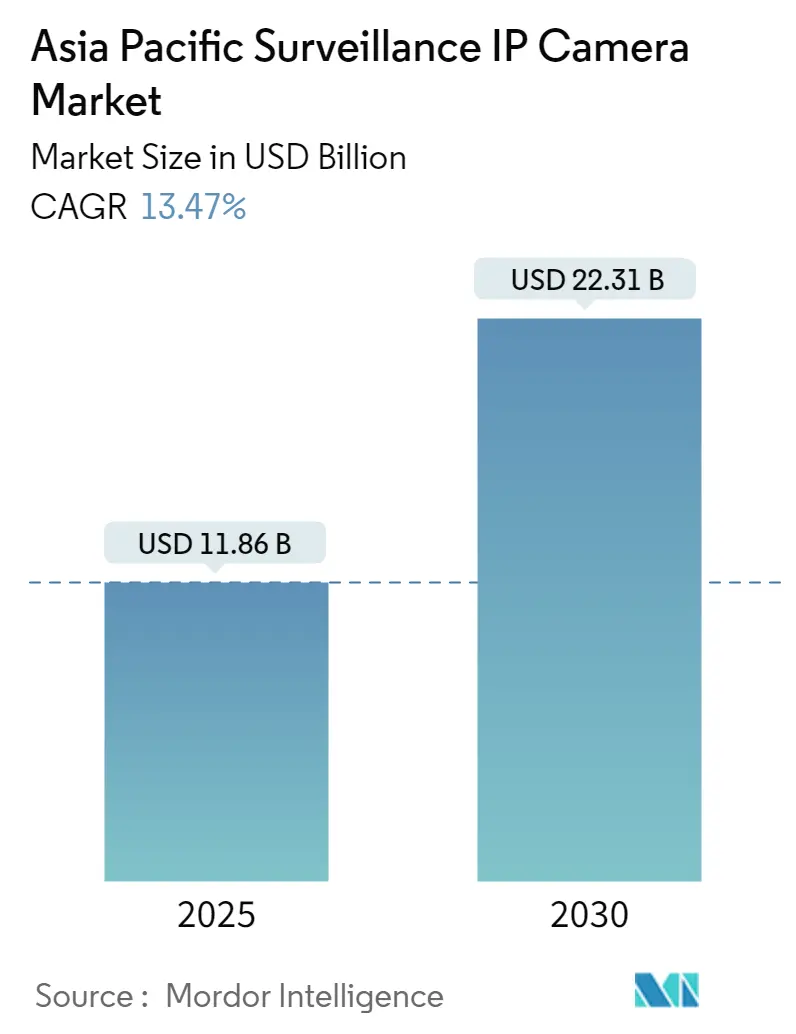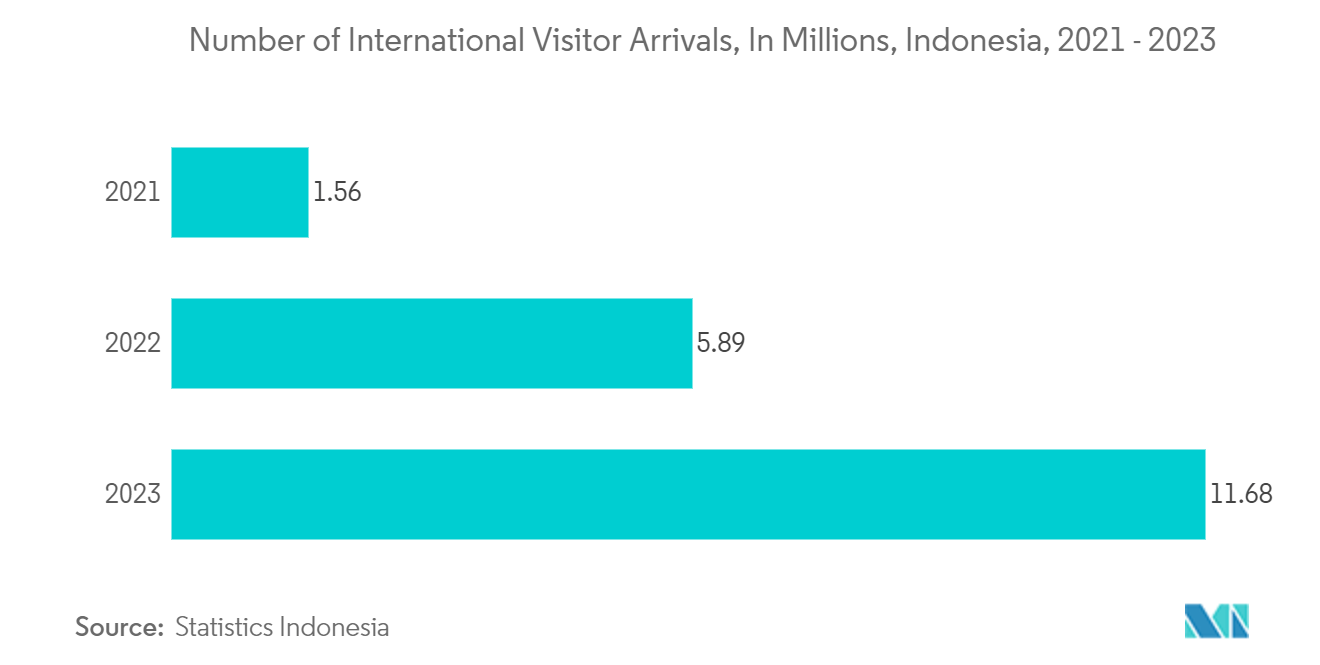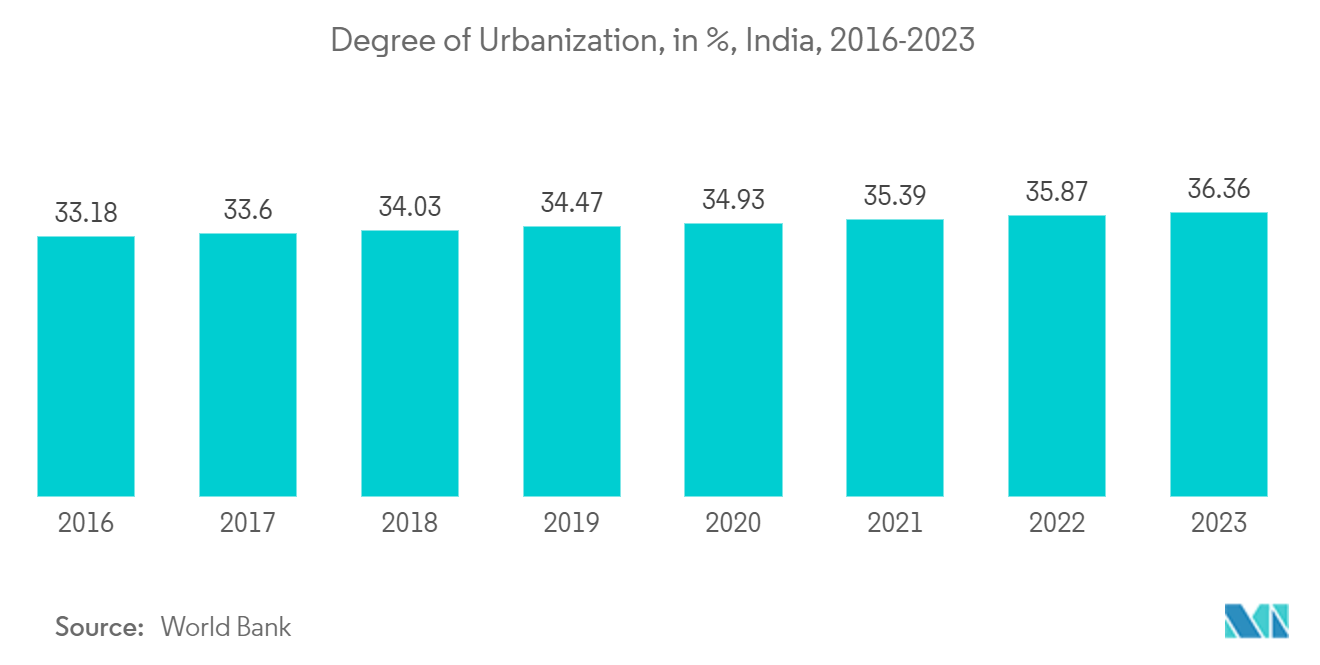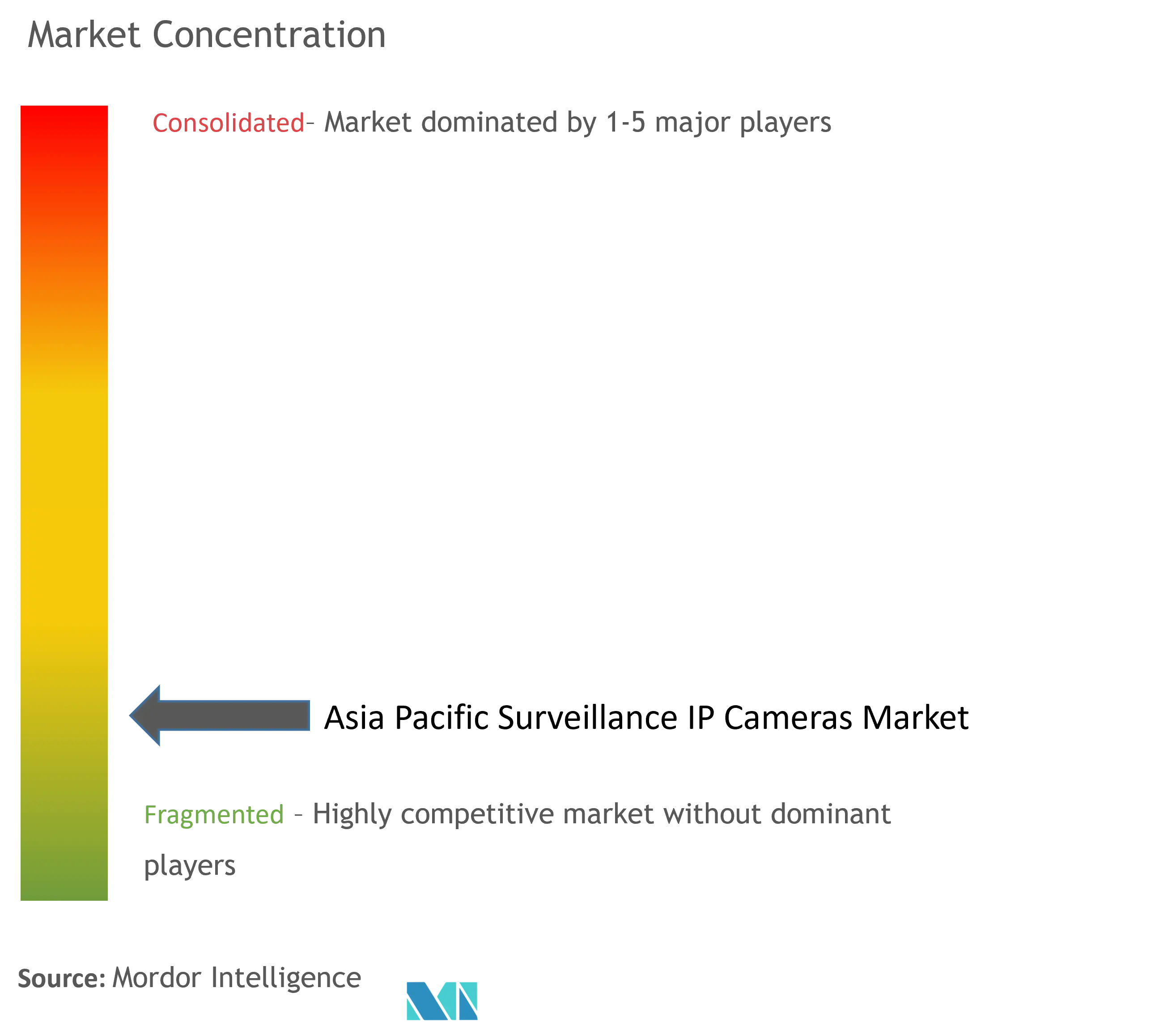Asia Pacific Surveillance IP Camera Market Size and Share

Asia Pacific Surveillance IP Camera Market Analysis by Mordor Intelligence
The Asia Pacific Surveillance IP Camera Market size is estimated at USD 11.86 billion in 2025, and is expected to reach USD 22.31 billion by 2030, at a CAGR of 13.47% during the forecast period (2025-2030).
- Governments throughout the region are investing in smart city initiatives, emphasizing public safety and urban management through surveillance systems. For example, India has been pursuing its smart city initiative for several years. As of July 2024, India's Union Housing and Urban Affairs Ministry announced that 100 cities have completed 7,188 projects, achieving 90% of the mission's total project goals. These efforts garnered a significant investment of INR 1,44,237 crore (approximately USD 17.22 billion).
- Meanwhile, Southeast Asian nations, including the Philippines, Thailand, and Vietnam, are mirroring India's efforts, directing significant resources toward their smart city agendas, a move poised to escalate the demand for surveillance IP cameras. For instance, in recent years, Vietnam has prioritized the development of smart cities, with key municipalities like Ho Chi Minh City, Can Tho, Hanoi, and Da Nang leading the charge in establishing smart city frameworks and progressively digitizing city and government services.
- China has pioneered in deploying comprehensive surveillance systems under initiatives like "Safe City" and "Skynet" to bolster public safety. Singapore, a global and regional frontrunner in smart city initiatives, is renowned for its cutting-edge technological infrastructure. The city-state has set an ambitious target of deploying over 200,000 police cameras by 2030. On a similar note, the Hong Kong government has unveiled plans to roll out more than 2,000 surveillance cameras, focusing on densely populated and high-crime areas, by the close of 2024.
- Urban areas' rising crime rates are fueling the demand for surveillance IP cameras. Notably, India, especially regions like Uttar Pradesh, Delhi, and Madhya Pradesh, is grappling with alarming rates of crimes against women. Delhi stands out as the most unsafe for women. The government is stepping up measures to combat these heinous crimes in response to mounting community pressure.
- With their superior image quality, advanced analytics, and remote access capabilities, IP cameras outshine analog systems. This has positioned them as the go-to choice for comprehensive surveillance needs. Their scalability, a feature lacking in traditional systems, allows for seamless expansion as demands increase. Recognizing this flexibility, governments in these regions are increasingly adopting IP cameras, propelling the market's growth.
- However, the public's growing unease with the proliferation of surveillance cameras presents a notable challenge for the market. Concerns center around potential abuses, unauthorized surveillance, and encroachments on privacy. Safeguarding the data gathered by IP cameras to protect individuals adds another layer of complexity to the issue.
Asia Pacific Surveillance IP Camera Market Trends and Insights
Government Sector Driving the Market
- In the Asia-Pacific region, the government segment is projected to continue to be a leading consumer of surveillance IP cameras. This trend is driven by an increasing number of initiatives and projects aimed at enhancing safety and security. For example, following a major earthquake in early 2024 and a rise in thefts and other crimes, Japan's government announced in January 2024 plans to strengthen security measures in central Japan. This initiative, led by the National Police Agency in collaboration with local police forces, targets installing around 1,000 security cameras, with a particular focus on evacuation centers.
- In December 2023, South Korea intensified its reliance on AI-driven surveillance as a measure against crime. Officials in Seoul unveiled plans to enhance the city's surveillance framework. The Seoul Metropolitan Government disclosed its strategy to install more AI-equipped closed-circuit television cameras in public parks and hiking trails, targeting areas previously vulnerable to crime. These developments further cultivate a conducive environment for the growth of the examined market.
- By 2026, South Korea aims to deploy 10,657 AI-equipped cameras in parks and hiking trails, particularly in areas experiencing higher crime rates and currently lacking surveillance. By the close of 2024, 4,748 of these cameras will be operational. The initiative also involves phasing out older cameras, starting with those below 1.3 million pixels. Such trends will also influence the demand for IP cameras in the region.
- Countries such as Singapore, Malaysia, and Indonesia are experiencing rapid urbanization. In response, these governments are significantly investing in surveillance systems to manage urban environments better and enhance public safety. Data from Indonesia's Statistical Authority highlights a surge in international tourism. In 2023, Indonesia recorded 11.68 million international visitors, a steady increase since 2021.
- Singapore's international visitor numbers in 2023 also jumped to 13.61 million, a sharp rise from 6.31 million in 2022. Malaysia also saw a significant boost, welcoming 20.1 million tourists, a 50% increase from the prior year. With safety being a crucial factor for tourists when choosing a destination, the region is poised for a substantial rise in the adoption of surveillance cameras, creating opportunities in the market.

India to Report a Notable Growth in Demand
- India is set to continue its status as a leading market for surveillance IP cameras. Government initiatives to enhance internal safety and security drive this market's expansion. For example, the Indian government is actively strengthening the nation's surveillance infrastructure. Through the Production Linked Incentive (PLI) Scheme, the government is promoting the domestic manufacturing of electronic components, including surveillance equipment. Additionally, the 'Make in India' initiative has spurred the emergence of local companies producing high-quality surveillance cameras. These efforts are fortifying the local supply chain of the surveillance camera industry, thereby positively influencing the market's growth.
- For instance, Prama India operates manufacturing facilities that produce high-quality video security products tailored to Indian standards and market demands. Several domestic companies like Zicom, Sparsh, Secureeye, Godrej, and CP Plus, among others, offer these products to Indian consumers at competitive prices. This accessibility bolsters the local surveillance camera ecosystem and fuels the growth of the surveillance IP camera market.
- Affordability is crucial, particularly since IP cameras generally come with a steeper price than their analog equivalents. The advantage of local production is becoming increasingly significant, especially as numerous businesses face tight budgets. As a result, many vendors are prioritizing a stronger local presence. For example, in January 2024, Johnson Controls, a leading US-based entity in smart security solutions, launched its new line of advanced security cameras. These cameras, crafted and manufactured in India, feature a localization rate surpassing 75%. This move underscores the company's commitment to the government's 'Make in India' initiative and signals intentions to shift entirely to local manufacturing soon.
- Recognizing the efficacy of Surveillance IP cameras, the government is increasingly turning to them for enhanced traffic management. In a notable example, the city of Guwahati in India has deployed the Integrated Traffic Management System (ITMS) cameras to curb traffic rule violations. Leveraging standard surveillance IP cameras, the Intelligent Traffic Management System captures videos for analysis. The police report an average collection of around USD 18,000 from violators since the ITMS installation.
- The Delhi Transport Department is set to roll out more than 5,000 cameras as part of its Intelligent Traffic Management System, aiming to reduce traffic violations. This move aligns with a growing trend in states such as Uttar Pradesh and Kerala and cities like Jaipur and Kolkata, where IP cameras have become a staple for traffic oversight. With India's vast population, the embrace of ITMS is on the brink of a significant upswing.
- Moreover, as urbanization intensifies in India, the nation increasingly prioritizes security and surveillance, especially in light of its historical security challenges. The World Bank reports that India's urbanization rate climbed to 36.36% in 2023, up from 33.18% in 2016. Consequently, these trends are expected to create new opportunities in the market under study during the forecast period.

Competitive Landscape
The Asia-Pacific Surveillance IP Camera market is fragmented, with major international players competing by offering technologically advanced products. The market features a wide range of manufacturers offering various technologies and solutions. Many companies compete in the market, offering various surveillance camera types and integration services.
In August 2024, Secureye, a frontrunner in the security and surveillance domain, unveiled its cutting-edge PHOENIX IP camera series. With its state-of-the-art features, this launch underscores Secureye's unwavering commitment to innovation and high quality in the security and surveillance arena.
In April 2024, Ajax Systems unveiled a new series of wired security IP cameras, delivering high-definition surveillance alongside strong privacy safeguards. The lineup features the BulletCam, TurretCam, and DomeCam Mini, each boasting unique specifications. Designed for versatility, these IP65-rated cameras are adept for both indoor and outdoor settings. Their password-less authentication ensures a seamless and secure setup. These cameras, equipped with diverse matrix types and lenses, meet a broad spectrum of video surveillance needs.
Asia Pacific Surveillance IP Camera Industry Leaders
-
Zhejiang Dahua Technology Co., Ltd.
-
Hangzhou Hikvision Digital Technology Co., Ltd.
-
Hanwha Vision
-
Bosch Sicherheitssysteme GmbH
-
Zosi Technology Ltd
- *Disclaimer: Major Players sorted in no particular order

Recent Industry Developments
- February 2024: Consistent Infosystems has bolstered its Security & Surveillance product lineup with a new series of 'Made in India' Surveillance Cameras. The comprehensive range features cutting-edge offerings like the Smart Wireless 4G PT Camera, the 4G Solar Camera, and the Wireless Pan-Tilt Wifi 3MP/4MP Mini Wi-Fi P2P. This expansion further solidifies Consistent Infosystems' position in the surveillance market.
- January 2024: Hikvision, a global leader in security solutions, enhances its camera range by introducing the Stealth Edition Cameras. These new additions, characterized by their black housings, offer a sleek aesthetic and boast cutting-edge features. They include 24/7 full-color capabilities with ColorVu and advanced AI detection for both humans and vehicles through AcuSense technology. With their striking black finish, the cameras seamlessly blend aesthetics with innovative features, notably their pioneering AI video technology.
Asia Pacific Surveillance IP Camera Market Report Scope
The study tracks the revenue accrued through selling surveillance IP camera products by various players operating in Asia-Pacific. The study also tracks the key market parameters, underlying growth influencers, and major vendors operating in the industry, which supports the market estimations and growth rates over the forecast period. The study further analyses the overall impact of macroeconomic factors on the market.
The Asia Pacific surveillance IP camera market is segmented by end-user industry (government, banking, healthcare, transportation and logistics, industrial, and other end-user industries) and by country (China, Japan, India, South Korea, and the rest of Asia-Pacific). The market sizes and forecasts are provided in terms of value (USD) for all the above segments.
| Government |
| Banking |
| Healthcare |
| Transportation and Logistics |
| Industrial |
| Other End-user Industries |
| China |
| Japan |
| India |
| South Korea |
| Taiwan |
| Indonesia |
| Australia and New Zealand |
| By End-user Industry | Government |
| Banking | |
| Healthcare | |
| Transportation and Logistics | |
| Industrial | |
| Other End-user Industries | |
| By Country*** | China |
| Japan | |
| India | |
| South Korea | |
| Taiwan | |
| Indonesia | |
| Australia and New Zealand |
Key Questions Answered in the Report
How big is the Asia Pacific Surveillance IP Camera Market?
The Asia Pacific Surveillance IP Camera Market size is expected to reach USD 11.86 billion in 2025 and grow at a CAGR of 13.47% to reach USD 22.31 billion by 2030.
What is the current Asia Pacific Surveillance IP Camera Market size?
In 2025, the Asia Pacific Surveillance IP Camera Market size is expected to reach USD 11.86 billion.
Who are the key players in Asia Pacific Surveillance IP Camera Market?
Zhejiang Dahua Technology Co., Ltd., Hangzhou Hikvision Digital Technology Co., Ltd., Hanwha Vision, Bosch Sicherheitssysteme GmbH and Zosi Technology Ltd are the major companies operating in the Asia Pacific Surveillance IP Camera Market.
What years does this Asia Pacific Surveillance IP Camera Market cover, and what was the market size in 2024?
In 2024, the Asia Pacific Surveillance IP Camera Market size was estimated at USD 10.26 billion. The report covers the Asia Pacific Surveillance IP Camera Market historical market size for years: 2019, 2020, 2021, 2022, 2023 and 2024. The report also forecasts the Asia Pacific Surveillance IP Camera Market size for years: 2025, 2026, 2027, 2028, 2029 and 2030.
Page last updated on:
Asia Pacific Surveillance IP Camera Market Report
Statistics for the 2025 Asia Pacific Surveillance IP Camera market share, size and revenue growth rate, created by Mordor Intelligence™ Industry Reports. Asia Pacific Surveillance IP Camera analysis includes a market forecast outlook for 2025 to 2030 and historical overview. Get a sample of this industry analysis as a free report PDF download.



